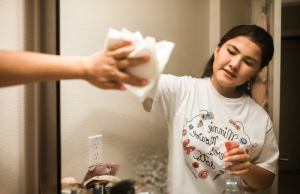
- Spring cleaning is as much of a tradition as it seems to be a natural urge. With winter behind us, and sunny weather in the days ahead, it seems only right to create a spring cleaning checklist.
- Powering through our spring cleaning checklist can produce a variety of benefits, helping us to feel accomplished; reducing symptoms of ADHD, depression, and anxiety; and even protecting our immune system.
- But before you start writing out your list, there are a few things to consider first: Walk around your home to identify the areas that seem the most chaotic and uncomfortable.
- You may also try involving your partner, children, or roommates in your spring cleaning efforts—which might foster some bonding experiences.
- It’s also helpful to consider accenting your frequently-used spaces with houseplants and to avoid creating a time crunch; give yourself plenty of breathing room in order to get your spring cleaning checklist knocked out.
It’s the time of year when everyone is feeling that big spring energy—and if you’re gearing up for warmer weather, more sunlight (finally), and anticipating a great summer, then spring cleaning might be top-of-mind. But before you go in on that junk drawer, or haphazardly sort through your closet to make a GoodWill pile, it might be time to make a spring cleaning checklist. It’s not nearly as tedious as it sounds—and spending a little time to craft a spring cleaning checklist is definitely worth it. After all, decluttering your home may help declutter your mind, too.

Why Is Spring Cleaning a Thing?
Spring cleaning’s origins lie in ancient Iran, what was once known as Persia. The Persian New Year (Nowruz) was a time for people to rid their house of dirt and excess belongings, take out the rugs and tidy up the kitchen—the whole deal. It’s continued on in a practice known as khaneh tekani, which translates to “shaking out the house,” and the rest of the world has followed suit.
Spring cleaning is intended to be as much of a mental relief as it is an environmental reset. There’s strong evidence to suggest that our home environment’s sense of orderliness significantly impacts our mental health state. Having a living space that’s neat and orderly lends a sense of stability, control, and peace. And after spending the winter with the windows and doors all closed off to the outside world, spring cleaning helps us keep pace with the vibes Mother Nature’s giving off.
The Mental Health Benefits of Spring Cleaning
Sure—your house may look (and feel) good after you’re done, but taking the time to work through a spring cleaning checklist offers some benefits that you may have never thought of. Did you know that:
- Spring cleaning can help us feel accomplished—and trains our brain that powering through our to-dos feels good, as our chemical reward system kicks in.
- For people who are struggling with ADHD, creating a plan (like a spring cleaning checklist) to become more organized can create a stronger sense of structure and order, which can help them to combat their symptoms.
- Spring cleaning may lessen the effects of depression and anxiety—people who are faced with uncomfortable emotions are more likely to describe their homes as messy or chaotic.
- By preventing the spread of indoor pathogens like influenza, salmonella, E. Coli, and others, spring cleaning is a great way to boost your immune system—which plays a huge role in your overall mental health.
It’s easy enough to grab a pen and pad, or whip out your phone and start typing away. But it’s also a great idea to be thorough with your spring cleaning checklist, so you can ensure that you give yourself the chance to create as positive of a home living space as possible.
How to Optimize Your Spring-Cleaning Checklist
To ensure that your spring cleaning checklist is thorough and get the most out of your deep scrub, you might keep these additions in mind:
- Taking a few minutes to walk around your living space before starting your list. You may discover nooks, corners, or areas of your home that give you a bit of a stifled, anxious feeling when you’re in them. These are places that you shouldn’t just clean; you should consider reorganizing them to feel more comfortable. Like in therapy sessions, we can’t fully address a problem until we can see the full extent to which it has bothered us.
- Collaborating with your roommate, partner, or kids in order to tackle your spring cleaning checklist. It’s not always going to be easy to share a living space with someone else. But taking on home-based activities together can be a great way to form a deeper bond with anyone you live with, and can also take the edge off the inevitable disagreements and arguing that will occur.
- Try finding some houseplants to accent your frequently-used spaces: Some people are wary to purchase a houseplant, worrying that they’ll kill it. There’s nothing wrong with buying false plants, but they won’t filter your office or living room’s air like the real thing. So even if it’s a cactus that you only remember to water 3 times a year, it may help you keep your mind clear and your overall being healthy—both emotionally and physically.
- Giving yourself enough time to accomplish everything on your list: Cramming a spring cleaning checklist into your Saturday with only a few hours to get it all done will leave you feeling even more stressed. Plan to set aside a full day (or several) to get everything done. Besides, you’ll have some time to make sure you have the cleaning supplies, boxes, trash bags, and other gear prepped and ready to go when it’s time to don your rubber gloves and get after it.
Everyone’s living space is different, so it’s likely that your spring cleaning checklist will be unique to you and your goals. But if you’ve been waiting all through the winter for a fresh start, this spring offers the perfect opportunity for you to do so—starting with decluttering your home.













